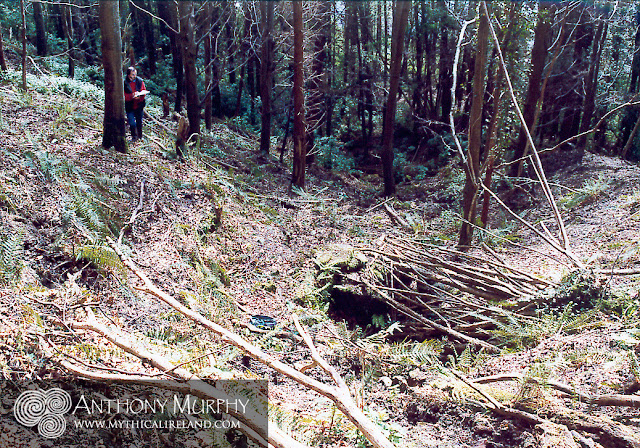
Mystery site - possible monument in heart of the Boyne Valley discovered by artist Richard Moore in 1999
In the summer of 1999, artist Richard Moore asked me if I would like to see a strange site that he had discovered in the heart of the Boyne Valley. It sounded intriguing. "What kind of site?" I asked. He said he didn't know, but that it was located in a place where it wouldn't be easily seen by archaeologists, and he said that as far as he could tell nobody knew about it but him.
The chance of an adventure into the Boyne Valley involving a mysterious unknown site, possibly an ancient monument, was indeed too tempting. So we agreed that the following weekend, we would go out there and I would bring my camera and he would bring his artist's sketch pad. The site is located on interesting terrain - a very steep forest-covered hillside that runs down to the Boyne river. It was difficult to access - even in dry weather. It can only be described as a semicircular man-made feature set into the side of the hill. There were stones forming a distinct semicircle that appeared to create a revetment. It is possible that the area within the semicircle has some sort of flagging stones on its floor - we certainly saw one large flat stone there, and there may have been others.
It's all so long ago now that I can't remember a huge amount about it. Without expert knowledge, I can only speculate that it might have either been some sort of holy or sacred well (now dry) or that it might have been some sort of shrine. My opinion, for what it's worth, is that this is a relatively modern construction, but the archaeologists will confirm this one way or the other. One problem on the two occasions we visited was that the feature was partially covered by fallen trees, and apart from the semicircular stone wall, there was little else to be discerned.
We did, of course, report the find to a couple of archaeologists at the time. However, at the time of writing this blog it appears this possible monument is not on the Sites and Monuments Record (SMR). A major reason for that is undoubtedly the fact that the site is in a location that makes it very difficult to access - and it's hardly likely to have been noticed by many people over the years. In fact, on my first visit (we were there twice; on the second occasion I slipped and fell on the wet incline and wounded little more than my pride!), I remember thinking "how the hell did Richard find this place?"
It was located on private land, and as always, Richard had sought the permission of the landowner to access the land. How he ended up on the site of a steep and somewhat treacherous bank in a forest suggests that he has an intrepid spirit that urges him to go beyond the call of normal duty in the search of new things to paint. Below are some more photos of the site:
The chance of an adventure into the Boyne Valley involving a mysterious unknown site, possibly an ancient monument, was indeed too tempting. So we agreed that the following weekend, we would go out there and I would bring my camera and he would bring his artist's sketch pad. The site is located on interesting terrain - a very steep forest-covered hillside that runs down to the Boyne river. It was difficult to access - even in dry weather. It can only be described as a semicircular man-made feature set into the side of the hill. There were stones forming a distinct semicircle that appeared to create a revetment. It is possible that the area within the semicircle has some sort of flagging stones on its floor - we certainly saw one large flat stone there, and there may have been others.
 |
| Richard Moore sketching the mystery site, which is covered by fallen trees. You can just see the Boyne through the trees. |
We did, of course, report the find to a couple of archaeologists at the time. However, at the time of writing this blog it appears this possible monument is not on the Sites and Monuments Record (SMR). A major reason for that is undoubtedly the fact that the site is in a location that makes it very difficult to access - and it's hardly likely to have been noticed by many people over the years. In fact, on my first visit (we were there twice; on the second occasion I slipped and fell on the wet incline and wounded little more than my pride!), I remember thinking "how the hell did Richard find this place?"
It was located on private land, and as always, Richard had sought the permission of the landowner to access the land. How he ended up on the site of a steep and somewhat treacherous bank in a forest suggests that he has an intrepid spirit that urges him to go beyond the call of normal duty in the search of new things to paint. Below are some more photos of the site:
 |
| The site viewed from above. |
 |
| Richard Moore points to a stone with a stick to add a sense of scale to the site. |
 |
| A large flat stone which might have been some sort of flag stone on the floor of the feature. |
 |
| Another view of the site showing how partial subsidence has concealed it. |
